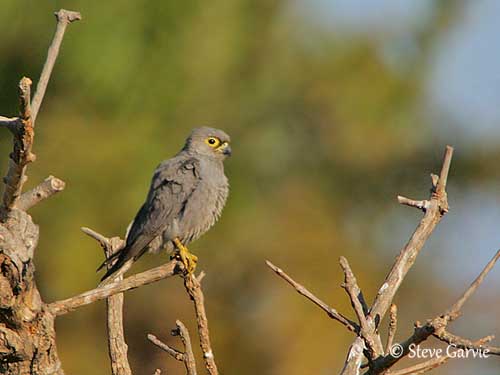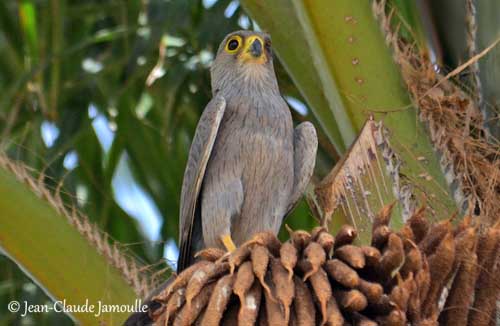
Fr: Faucon ardoisé
All : Graufalke
Esp : Cernícalo Pizarroso
Ital : Gheppio ardesia
Nd: Grijze Torenvalk
Sd: Grå tornfalk
Photographers:
Steve Garvie
RAINBIRDER Photo galleries
Jean-Claude Jamoulle
A la rencontre des Oiseaux
Text by Nicole Bouglouan
Sources:
HANDBOOK OF THE BIRDS OF THE WORLD Vol 2 by Josep del Hoyo-Andrew Elliot-Jordi Sargatal - Lynx Edicions - ISBN: 8487334156
BIRDS OF AFRICA SOUTH OF THE SAHARA by Ian Sinclair and Peter Ryan - Princeton University Press Princeton and Oxford - ISBN: 0691118159
BirdLife International (BirdLife International)
Global Raptor Information Network - Working to Conserve Birds of Prey in nature
Wikipedia, the free encyclopaedia
Grey Kestrel
Falco ardosiaceus
Falconiforme Order – Falconidae Family
BIOMETRICS:
Length: 30-33 cm
Weight: M: 205-255g – F: 240-300 g
DESCRIPTION:
The Grey Kestrel is a small, stocky, uniform grey bird of prey.
The adult male has entirely slate grey plumage, with light scaling pattern due to pale feather edges, and narrow darker grey streaks overall. The wings are fairly short and pointed. The tips of the primary flight feathers are blackish.
This kestrel can be confused with the Sooty Falcon (Falco concolor), but the Grey Kestrel is heavier and more compact, its wings are shorter and do not reach the tip of the tail when the bird is perched.
On the underparts, flight feathers and rectrices are barred pale grey.
The large head is slightly paler than the body. The bill is black with yellow cere. The eyes are brown, surrounded by broad bare bright yellow eyering. Legs and feet are yellow too.

The female is similar in plumage but she is slightly larger than male.
The juvenile has grey washed brown plumage, paler belly, and pale green, not yellow, facial skin.
VOICE: SOUNDS BY XENO-CANTO
The Grey Kestrel gives high-pitched, rasping trill “keek-keek-keek” at nest, and we can hear sometimes a whistling scream.
HABITAT:
The Grey Kestrel is found in savanna with large trees or palms, and open woodland, often close to burnt areas where it can hunt.
This species can be seen up to 1800 metres of elevation.
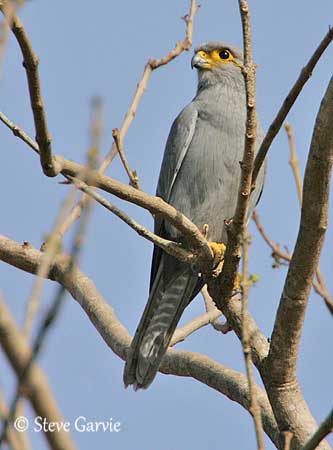
RANGE:
The Grey Kestrel occurs in Senegambia, E to Ethiopia and S through W Kenya and W Tanzania to Angola, N Zambia, N Namibia and NW Botswana.
BEHAVIOUR:
The Grey Kestrel feeds on various preys such as large insects, small reptiles, small birds, rodents, bats, amphibians and numerous insects. It may sometimes eat oil palm fruits.
It usually occurs singly or in pairs, but swarming termites often attract foraging flocks.
This small falcon hunts usually from high, exposed perch, mainly during the warm hours of the day, when preys are active. Once the prey is detected, it flies down the perch and catches it on the ground, low branches or foliage.
It may run along the ground for termites.
It also flies in slow prospecting flight. It is able, like most Falconidae species, to perform fast aerial chases with rapid wingbeats, and insects are often caught by aerial hawking. However, this species rarely hovers.
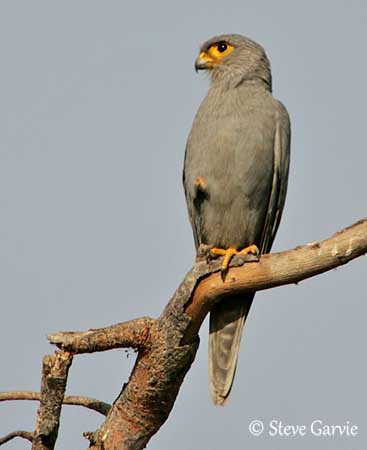
At the beginning of the breeding season, both mates perform aerial displays. They soar together, and one of them dives at its partner which rolls and flies on its back while presenting talons to the bird above.
Copulation occurs on the nest, and both mates often roost at nest during the breeding season. They are territorial during this period.
This shy, silent species is resident in most parts of the range, and there is no evidence suggesting regular movements, except in W Africa where the Grey Kestrel moves north with the rains, and south during the dry season.
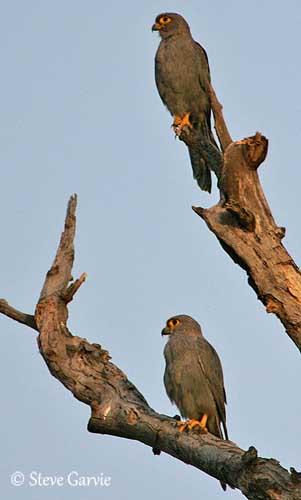
FLIGHT:
The Grey Kestrel flies low over open areas or even among trees, performing fast, shallow wingbeats interspersed with short glides.
REPRODUCTION:
The breeding season varies according to the range. It usually occurs between January and April in W Africa and between August and October in Kenya, Tanzania and Angola.
The Grey Kestrel nests in tree cavities or abandoned stick nests, but most often in cavity in huge, old stick nest of Hamerkop (Scopus umbretta). It may even evict the resident birds.
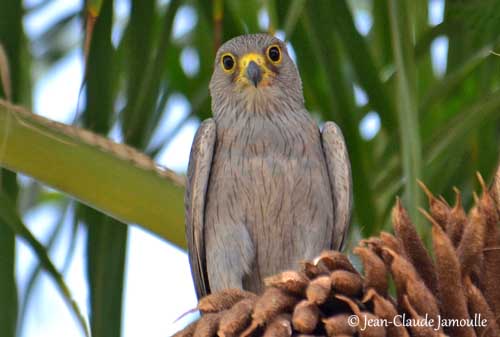
The female lays 3-5 white eggs with darker markings. Incubation, mainly by female, lasts about one month during which the male provides her some preys at nest.
At hatching, the chicks are covered in white down. They are fed by both parents, and fledge about one month after hatching.
DIET:
The Grey Kestrel feeds mainly on grasshoppers and small reptiles (lizards, snakes and chameleons). It may take small birds, rodents and bats, but also grogs and earthworms and numerous insects. Other arthropods include crabs and myriapods. It may sometimes eat oil palm fruits.
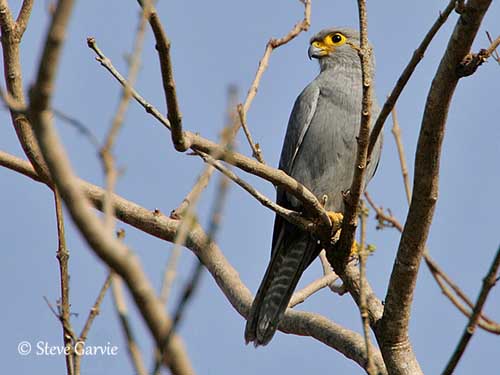
PROTECTION / THREATS / STATUS:
The Grey Kestrel is fairly common in several parts of the range, as well in natural reserves as in large areas of natural habitat. This species has benefited from clearance of tropical rain forest, and is often seen hunting in agricultural areas.
The Grey Kestrel is not currently threatened.
